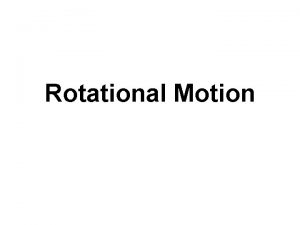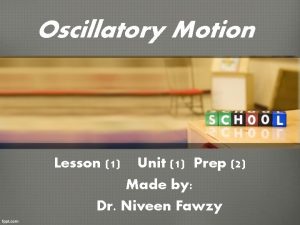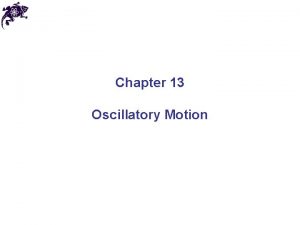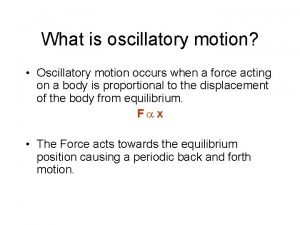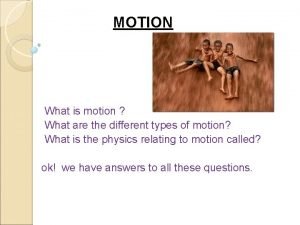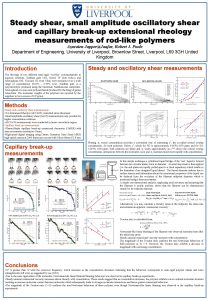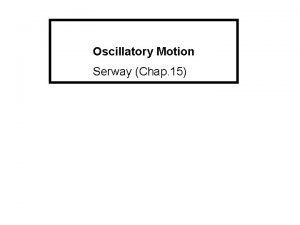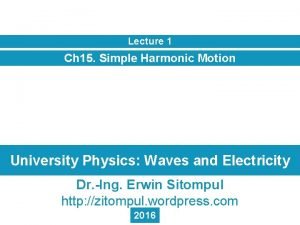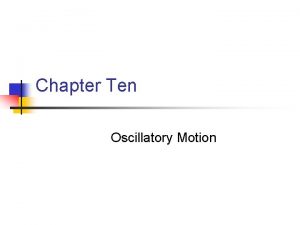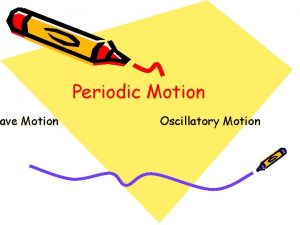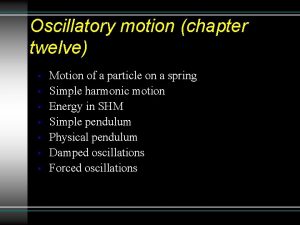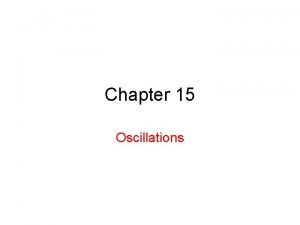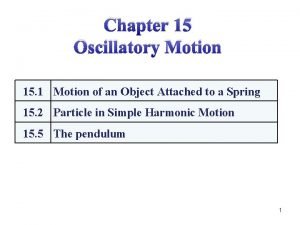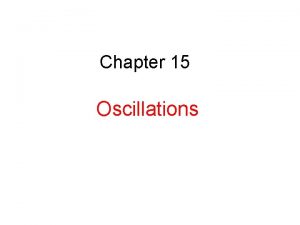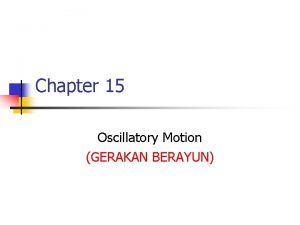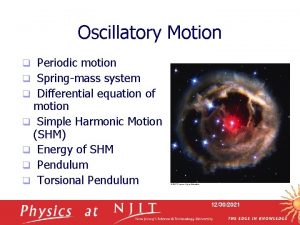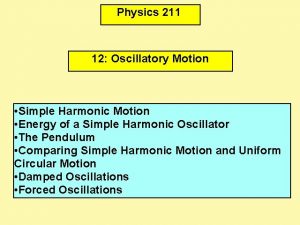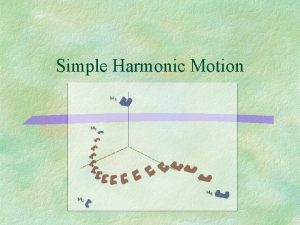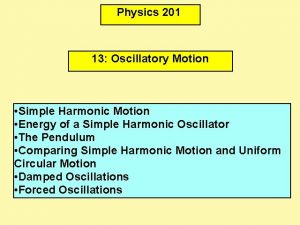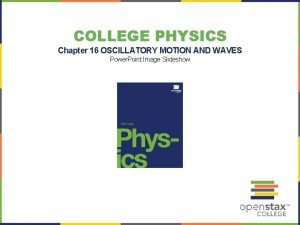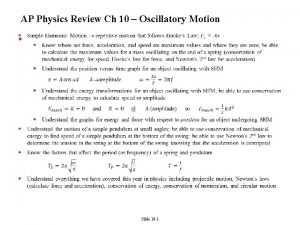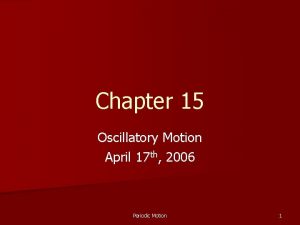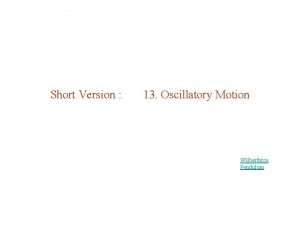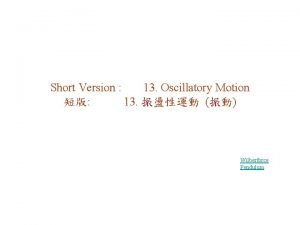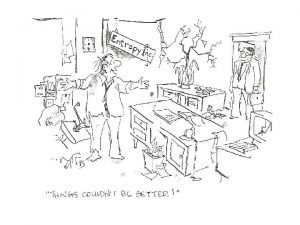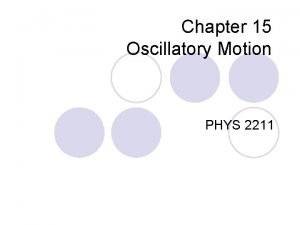Lecture 9 Oscillatory Motion Outline 10 1 The





















































- Slides: 53

Lecture 9 Oscillatory Motion

Outline •

10. 1 The Ideal Spring and Simple Harmonic Motion spring constant Units: N/m �������������������������� (���������� (

10. 1 The Ideal Spring and Simple Harmonic Motion HOOKE’S LAW: RESTORING FORCE OF AN IDEAL SPRING The restoring force on an ideal spring is

10. 1 The Ideal Spring and Simple Harmonic Motion Conceptual Example : Are Shorter Springs Stiffer? �������������� ? A 10 -coil spring has a spring constant k. If the spring is cut in half, so there are two 5 -coil springs, what is the spring constant of each of the smaller springs?

10. 2 Simple Harmonic Motion and the Reference Circle DISPLACEMENT

10. 2 Simple Harmonic Motion and the Reference Circle

10. 2 Simple Harmonic Motion and the Reference Circle amplitude A: the maximum displacement period T: the time required to complete one cycle frequency f: the number of cycles per second (measured in Hz)

10. 2 Simple Harmonic Motion and the Reference Circle VELOCITY

10. 2 Simple Harmonic Motion and the Reference Circle Example The Maximum Speed of a Loudspeaker Diaphragm The frequency of motion is 1. 0 KHz and the amplitude is 0. 20 mm. (a) What is the maximum speed of the diaphragm? (b) Where in the motion does this maximum speed occur?

10. 2 Simple Harmonic Motion and the Reference Circle (a) (b) The maximum speed occurs midway between the ends of its motion.

10. 2 Simple Harmonic Motion and the Reference Circle ACCELERATION

10. 2 Simple Harmonic Motion and the Reference Circle FREQUENCY OF VIBRATION

10. 2 Simple Harmonic Motion and the Reference Circle Example A Body Mass Measurement Device The device consists of a spring-mounted chair in which the astronaut sits. The spring has a spring constant of 606 N/m and the mass of the chair is 12. 0 kg. The measured period is 2. 41 s. Find the mass of the astronaut.

10. 2 Simple Harmonic Motion and the Reference Circle

10. 3 Energy and Simple Harmonic Motion A compressed spring can do work.

10. 3 Energy and Simple Harmonic Motion

10. 3 Energy and Simple Harmonic Motion DEFINITION OF ELASTIC POTENTIAL ENERGY The elastic potential energy is the energy that a spring has by virtue of being stretched or compressed. For an ideal spring, the elastic potential energy is SI Unit of Elastic Potential Energy: joule (J)

10. 3 Energy and Simple Harmonic Motion Conceptual Example Changing the Mass of a Simple Harmonic Oscillator The box rests on a horizontal, frictionless surface. The spring is stretched to x=A and released. When the box is passing through x=0, a second box of the same mass is attached to it. Discuss what happens to the (a) maximum speed (b) amplitude (c) angular frequency.

Homework: Vertical Spring A 0. 20 -kg ball is attached to a vertical spring. The spring constant is 28 N/m. When released from rest, how far does the ball fall before being brought to a momentary stop by the spring?

Summary of SHM Math: definition of period (periodic function COS and SIN) Physics: What determines the period/frequency of SHM ?


SHM Example 1 From graph 1. initial conditions: x(0)=A, v(0)=0 2. What is f ? 3. Write x(t), v(t), a(t)? • The acceleration reaches extremes of ± w 2 A at ±A. • The velocity reaches extremes of ± w. A at x = 0. Section 15. 2

SHM Example 2 • Section 15. 2

Importance of Simple Harmonic Oscillators • Simple harmonic oscillators are good models of a wide variety of physical phenomena. • Molecular example – If the atoms in the molecule do not move too far, the forces between them can be modeled as if there were springs between the atoms. – The potential energy acts similar to that of the SHM oscillator. Potential energy actual P. E.

SHM and Circular Motion • Section 15. 4

SHM and Circular Motion, 4 • The angular speed of P is the same as the angular frequency of simple harmonic motion along the x axis. • Point Q has the same velocity as the x component of point P. • The x-component of the velocity is v = -w A sin (w t + f) Section 15. 4

SHM and Circular Motion, 5 • The acceleration of point P on the reference circle is directed radially inward. • P ’s acceleration is a = w 2 A • The x component is –w 2 A cos (wt + f) • This is also the acceleration of point Q along the x axis. Section 15. 4

10. 4 The Pendulum A simple pendulum (�������� ) consists of a particle attached to a frictionless pivot)������� ) by a cable of negligible mass.

10. 4 The Pendulum Example Keeping Time ������������� (������� �� ) ���������������� ����������������� Determine the length of a simple pendulum that will swing back and forth in simple harmonic motion with a period of 1. 00 s.

10. 5 Damped Harmonic Motion In simple harmonic motion, an object oscillated with a constant amplitude. In reality, friction or some other energy dissipating mechanism is always present and the amplitude decreases as time passes. This is referred to as damped harmonic motion.

Damped Oscillation: model • Section 15. 6

Damped Oscillations • The amplitude decreases with time. • The dashed lines represent the envelope of the motion. Section 15. 6

Damped Harmonic Motion �������� (damping force) 34

10. 5 Damped Harmonic Motion • • SHM with no damping Under-damped SHM Critically-damped SHM Over-damped SHM A, B เปนคาคงท

10. 6 Driven Harmonic Motion and Resonance When a force is applied to an oscillating system at all times, the result is driven harmonic motion. Here, the driving force has the same frequency as the spring system and always points in the direction of the object’s velocity.


10. 6 Driven Harmonic Motion and Resonance RESONANCE Resonance is the condition in which a time-dependent force can transmit large amounts of energy to an oscillating object, leading to a large amplitude motion. Resonance occurs when the frequency of the force matches a natural frequency at which the object will oscillate.

Resonance • When the frequency of the driving force is near the natural frequency (wf » w 0) an increase in amplitude occurs. • This dramatic increase in the amplitude is called resonance. • The natural frequency w 0 is also called the resonance frequency of the system. • At resonance, the applied force is in phase with the velocity and the power transferred to the oscillator is a maximum. – The applied force and v are both proportional to sin (wt + f). – The power delivered is F. v • This is a maximum when the force and velocity are in phase. • The power transferred to the oscillator is a maximum. Section 15. 7

Resonance, cont. • Resonance (maximum peak) occurs when driving frequency equals the natural frequency. • The amplitude increases with decreased damping. • The curve broadens as the damping increases. • The shape of the resonance curve depends on b. Section 15. 7

10. 7 Elastic Deformation (���������������� ) Because of these atomic-level “springs”, a material tends to return to its initial shape once forces have been removed. ATOMS FORCES

10. 7 Elastic Deformation STRETCHING, COMPRESSION, AND YOUNG’S MODULUS Young’s modulus has the units of pressure: N/m 2


Stress, Strain and Hooke’s Law In general the quantity F/A is called the stress. The change in the quantity divided by that quantity is called the strain: HOOKE’S LAW FOR STRESS AND STRAIN Stress is directly proportional to strain. Strain is a unitless quantitiy. SI Unit of Stress: N/m 2


10. 7 Elastic Deformation Example Bone Compression In a circus act, a performer supports the combined weight (1080 N) of a number of colleagues. Each thighbone of this performer has a length of 0. 55 m and an effective cross sectional area of 7. 7× 10 -4 m 2. Determine the amount that each thighbone compresses under the extra weight.

10. 7 Elastic Deformation

10. 7 Elastic Deformation SHEAR DEFORMATION AND THE SHEAR MODULUS The shear modulus has the units of pressure: N/m 2

10. 7 Elastic Deformation

10. 7 Elastic Deformation Example J-E-L-L-O You push tangentially across the top surface with a force of 0. 45 N. The top surface moves a distance of 6. 0 mm relative to the bottom surface. What is the shear modulus of Jell-O?

10. 7 Elastic Deformation

10. 7 Elastic Deformation VOLUME DEFORMATION AND THE BULK MODULUS The Bulk modulus has the units of pressure: N/m 2

10. 7 Elastic Deformation
 Difference between force and torque
Difference between force and torque Oscillatory motion
Oscillatory motion Oscillatory motion
Oscillatory motion Oscillatory motion
Oscillatory motion Oscillatory motion
Oscillatory motion Small amplitude oscillatory shear
Small amplitude oscillatory shear Oscillatory
Oscillatory 01:640:244 lecture notes - lecture 15: plat, idah, farad
01:640:244 lecture notes - lecture 15: plat, idah, farad Lecture outline example
Lecture outline example Lecture outline example
Lecture outline example Lecture outline example
Lecture outline example Lecture outline meaning
Lecture outline meaning Slidetodoc
Slidetodoc Simple harmonic motion lecture
Simple harmonic motion lecture Example of sentence outline about education
Example of sentence outline about education Range of motion types
Range of motion types Simple harmonic motion formula
Simple harmonic motion formula An object in motion stays in motion
An object in motion stays in motion Chapter 2 motion section 1 describing motion answer key
Chapter 2 motion section 1 describing motion answer key Measuring motion
Measuring motion Chapter 2 motion section 1 describing motion answer key
Chapter 2 motion section 1 describing motion answer key Chapter 1 lesson 2 describing motion answer key
Chapter 1 lesson 2 describing motion answer key Section 1 describing motion
Section 1 describing motion Hình ảnh bộ gõ cơ thể búng tay
Hình ảnh bộ gõ cơ thể búng tay Slidetodoc
Slidetodoc Bổ thể
Bổ thể Tỉ lệ cơ thể trẻ em
Tỉ lệ cơ thể trẻ em Chó sói
Chó sói Tư thế worms-breton
Tư thế worms-breton Alleluia hat len nguoi oi
Alleluia hat len nguoi oi Các môn thể thao bắt đầu bằng tiếng đua
Các môn thể thao bắt đầu bằng tiếng đua Thế nào là hệ số cao nhất
Thế nào là hệ số cao nhất Các châu lục và đại dương trên thế giới
Các châu lục và đại dương trên thế giới Công của trọng lực
Công của trọng lực Trời xanh đây là của chúng ta thể thơ
Trời xanh đây là của chúng ta thể thơ Cách giải mật thư tọa độ
Cách giải mật thư tọa độ 101012 bằng
101012 bằng độ dài liên kết
độ dài liên kết Các châu lục và đại dương trên thế giới
Các châu lục và đại dương trên thế giới Thể thơ truyền thống
Thể thơ truyền thống Quá trình desamine hóa có thể tạo ra
Quá trình desamine hóa có thể tạo ra Một số thể thơ truyền thống
Một số thể thơ truyền thống Cái miệng xinh xinh thế chỉ nói điều hay thôi
Cái miệng xinh xinh thế chỉ nói điều hay thôi Vẽ hình chiếu vuông góc của vật thể sau
Vẽ hình chiếu vuông góc của vật thể sau Nguyên nhân của sự mỏi cơ sinh 8
Nguyên nhân của sự mỏi cơ sinh 8 đặc điểm cơ thể của người tối cổ
đặc điểm cơ thể của người tối cổ V. c c
V. c c Vẽ hình chiếu đứng bằng cạnh của vật thể
Vẽ hình chiếu đứng bằng cạnh của vật thể Vẽ hình chiếu vuông góc của vật thể sau
Vẽ hình chiếu vuông góc của vật thể sau Thẻ vin
Thẻ vin đại từ thay thế
đại từ thay thế điện thế nghỉ
điện thế nghỉ Tư thế ngồi viết
Tư thế ngồi viết Diễn thế sinh thái là
Diễn thế sinh thái là
